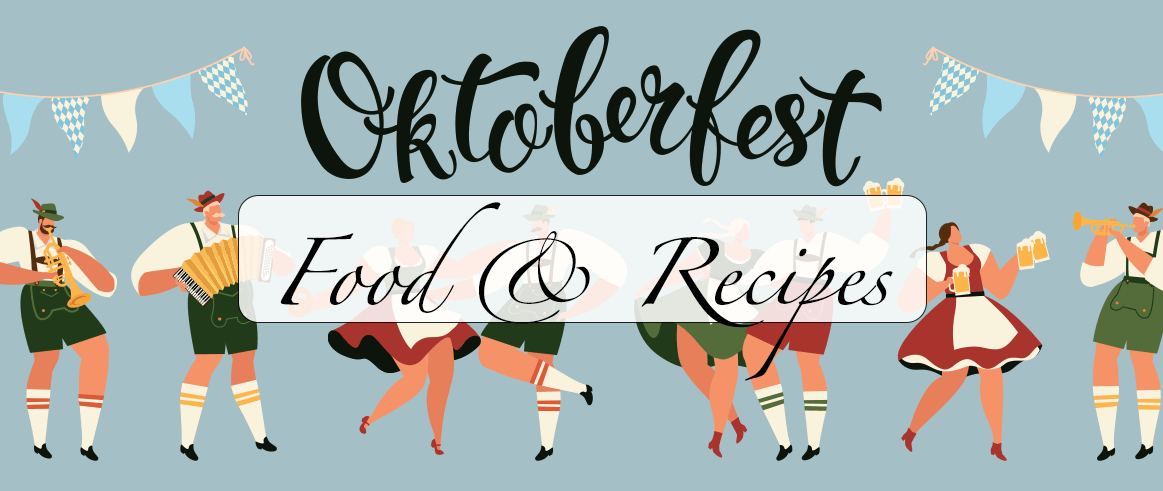Written by Jaden Parker
Oktoberfest food. My mouth is watering just thinking about those giant Brez’n (pretzels) and various meats, especially the different types of sausages! I scoured the internet and created this short and sweet version of anything and everything Oktoberfest food. Let’s dig in!
According to the Oktoberfest Guide, meat grilled whole is always available because it is prepared to perfection hours in advance in order to serve thousands at the festival. Schweinswürstl is a classic (pork sausages with sauerkraut) and is generally cheap. They still serve just bread and cheese, or Brotzeiten (which translates to “Bread times”), as a popular cold starter or entree to pay homage to the first foods of Oktoberfest. Brotzeitbett, or mixed platters of cold dishes, can include anything from Pressack (head cheese), Radi (salted radish) or Essiggurken (pickles) to Wurstsalat (sausage salad), cold pork roast, and Obazda (spread cheese). And how can I forget the Wurst?
Your Guide to the Wurst Part of Oktoberfest:
- Bratwurst: the most famous German sausage made from veal, beef, or pork
- Weisswurst: the white sausage made from minced veal and back bacon without any preservatives; Germans say that weisswurst should not be allowed to hear the noon chime of the church bells, so this sausage is only eaten during breakfast!
- Blutwurst: literally translates to “blood sausage” and is made with pork rind and blood cooked down with barley
- Currywurst: this is actually a dish made with a boiled and fried bratwurst covered in tomatoes and Worcestershire sauce before being peppered with curry powder; It was invented in 1949 by Herta Heuwer and has its own museum now!
- Bockwurst: the sausage made with finely ground pork and veal; it contains a higher ratio of veal than bratwurst
- Leberwurst: a sausage spread made with pigs’ or calves’ livers
- Nuremberg wurst: long and skinny sausage made from lean pork and beef
- Frankfurter Würstchen: this is Germany’s second favorite sausage; it’s the hot dog
- Thüringer Rostbratwurst: one of the oldest known German sausages; it was given PGI status under European law; only made with finely minced pork, beef, and occasionally veal; at least 51% of the ingredients must come from Thüringia
Moving on to the pastries, sweets are typically served as main dishes instead of desserts. At Oktoberfest, you can find Kaiserschmarrn, which is a caramelized pancake cut up into pieces and eaten with either an apple puree or stewed plums. Let us not forget about the dumplings! You can order from a variety like Damfnudel (a sweet dumpling with a caramelized bottom), Buchteln (a sweet roll filled with powidl, a prune plum fruit spread), Germknödel (a dumpling with spiced plum jam and topped with poppy seeds and sugar), or Marrillenknödel (Austrian apricot dumplings). You can also try other apple-based sweets like Apfelkücherl (fried apple rings) or Apfelstrudel! If you’re looking for something without fruit, you should try Auszogne or Bavesen, which are just fried dough pastries.

Booths at Oktoberfest typically have cheaper food than at the beer gardens. Luckily, you can bring any food you want into a beer garden; you just have to order your beer from inside the beer garden. Booths sell cold sausages, Fischsemmel (fish rolls), cheese, Leberkas (Bavarian meatloaf), and, of course, Schnitzel rolls. Fun fact: Munich leases bread booths outside the beer gardens to people in need! Also, Oktoberfest’s most popular candy is roasted almonds. Looking for something a little bit more savory? Try Spätzle, which is bacon-covered macaroni and cheese. (Quick tip: Vegetarians, you can order it sans bacon.)
To conclude before we treat you with a special recipe, the Oktoberfest Guide has the following warning when it comes to eating Oktoberfest food:
- Schweinsbraten (pork roast) is typically overpriced at the festival and can be found at any Bavarian restaurant. Your best bet is to enjoy food you won’t be able to get anywhere else at such a good value. Fried foods are often 50% more expensive, too.
As promised, one of our team was able to procure an adapted New York Times recipe from a friend. Here is how to make Marian Burros’ Plum Torte with a few adjustments courtesy of Angelika Ridulfo!
Plum Torte
Yield: 8 servings
INGREDIENTS
- ½ cup sugar
- ½ cup unsalted butter, softened
- 1 cup unbleached flour, sifted
- 1 tsp. baking powder
- Pinch of salt (optional)
- 2 eggs
- 24 halves pitted purple plums
- Sugar and cinnamon, for topping
PREPARATION
- Heat oven to 350 degrees.
- Cream the sugar and butter in a bowl. Add the flour, baking powder, salt and eggs and beat well.
- Spoon the batter into a springform pan of 8, 9, or 10 inches. Place the plum halves skin side up on top of the batter. Sprinkle lightly with sugar, depending on the sweetness of the fruit. Sprinkle with about 1 teaspoon of cinnamon, depending on how much you like cinnamon.
- Bake for 1 hour, approximately. Remove and cool; refrigerate or freeze if desired. Or cool to lukewarm and serve plain or with whipped cream. (To serve a torte that was frozen, defrost and reheat it briefly at 300 degrees.)
TIP
To freeze, double-wrap the torte in foil, place in a plastic bag and seal.










